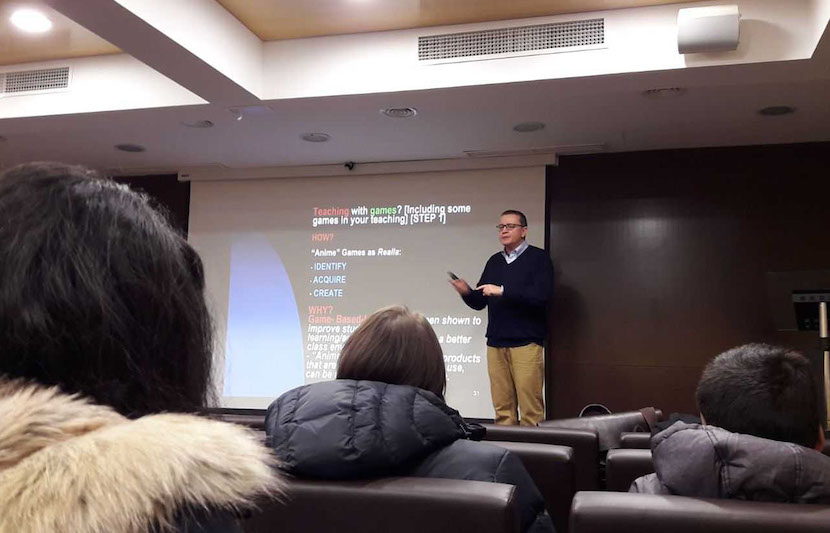A professor at Saint Louis University (SLU) has effectively used video games to teach his students language and culture.
Simone Bregni, associate professor of languages, literatures and cultures at SLU, began playing video games in 1975 when he was only 12 years old. In those days the most popular game was “Pong,” a simple and primitive game meant to replicate ping pong.
By the mid-80s Bregni, whose first language was Italian, was playing early adventure games and started to notice his English was improving as he played. He soon developed a deep passion for video games and language that have grown simultaneously to this day.
“I realized that my English (and, later, French and Spanish) language skills rapidly improved while I was having fun,” said Bregni. “Playing narrative-oriented quests in video games, not only was I reading in a foreign language, I was also applying my reading comprehension to problem-solving, and using writing to attain goals and solutions.”
His love for video games and eagerness to incorporate them into teaching methods led him to work for an Italian video game publication in the 1990s. There he served as a correspondent reporting about the video game industry and wrote a column on the history of video games.
Bregni first started his work regarding video games as a tool for education in 1997 with the rise of the Playstation and role-playing games, such as the “Final Fantasy” series.

Video Games for Language
Recently, he received a fellowship grant from SLU’s Reinert Center for Transformative Teaching and Learning to establish a language course based on gaming.
The class provides students with two semesters worth of learning over the course of one fall semester. By the end of the semester, the students who took Bregni’s course scored three to five points ahead of students who took the traditional course.
Students who took Bregni’s course would start by learning traditional action verbs, said Bregni. They would then play the first chapter of “Rise of the Tomb Raider,” which presents many of those verbs in context.
A worksheet he created then guides students through this process.
“Finally, students would be called to discuss, and write about, the gaming narrative first, and then about their own life experiences, by applying the vocabulary, verbs and structures they have just learned,” said Bregni.
He calls this process Identify, Acquire, Create (IAC). Students first identify already known vocabulary and structures. Then they acquire new vocabulary words through a series of task-based exercises, and finally create written texts and spoken discourse, explained Bregni.
On a typical day in the classroom, students would spend 30 minutes learning through traditional techniques and spend 20 minutes gaming.

Video Games for Culture
Bregni also uses games like “Assassin’s Creed II” to teach students about the culture and history of Italy.
“In my Italian Renaissance literature course, for example, students explore Florence as it flourished under the Medici by playing ‘Assassin’s Creed II,’” Bregni said in his paper. “My 21st-century American students partake in the life of Ezio Auditore, a 20-something man from an affluent family, by wandering around a cultural and historical re-creation of 1476 Florence.”
He has also used the games “Final Fantasy,” “Trivial Pursuit,” “Who Wants to be a Millionaire” and “Heavy Rain” in his teachings.
“The use of video games and other related realia (online gaming magazines, YouTube videos, reviews, etc.), both in and outside the classroom, has been shown to be a very effective didactic tool for reinforcing linguistic skills and exposing students to contemporary cultures of other nations and groups,” said Bregni.
“Cinematic games contain plenty of opportunities to reinforce a variety of grammatical forms and explore new vocabulary through listening and reading comprehension, lexical expansion and problem solving,” he continued. “They can be used at all levels, in one form or another, and as a lab or classroom activity.”
While Bregni doesn’t believe that video games and other digital realia should replace traditional teaching methods, he is convinced that they can reinforce and expand vocabulary and structures.
The Inspiration
Bregni bases his teaching method on personal experiences.
He is more likely to remember information that comes from song, comic books, magazines, TV shows or video games.
“These sources reinforced grammatical structures learned through traditional instruction, but they also taught me idioms and slang, all of which I would not have been able to access in a ‘regular’ classroom,” said Bregni.
Extension of Method
Bregni’s method has extended past Italian. The Reinert Center and the language learning studio of the Department of Languages, Literatures and Cultures now have games that can be played in German, French, Spanish, Russian and Chinese.
This semester, Bregni is conducting gaming and language workshops in multiple European cities, including SLU’s campus in Madrid.
Bregni was awarded the James H. Korn Scholarship of Teaching and Learning Award by the Reinert Center in 2017. “My course could serve as a model for a mixed/blended learning format that could be applied to other languages and even other fields,” said Bregni. “After all, video games lend themselves to some interesting potential multidisciplinary developments in, among other subjects, such as History, Art and Architecture.”


